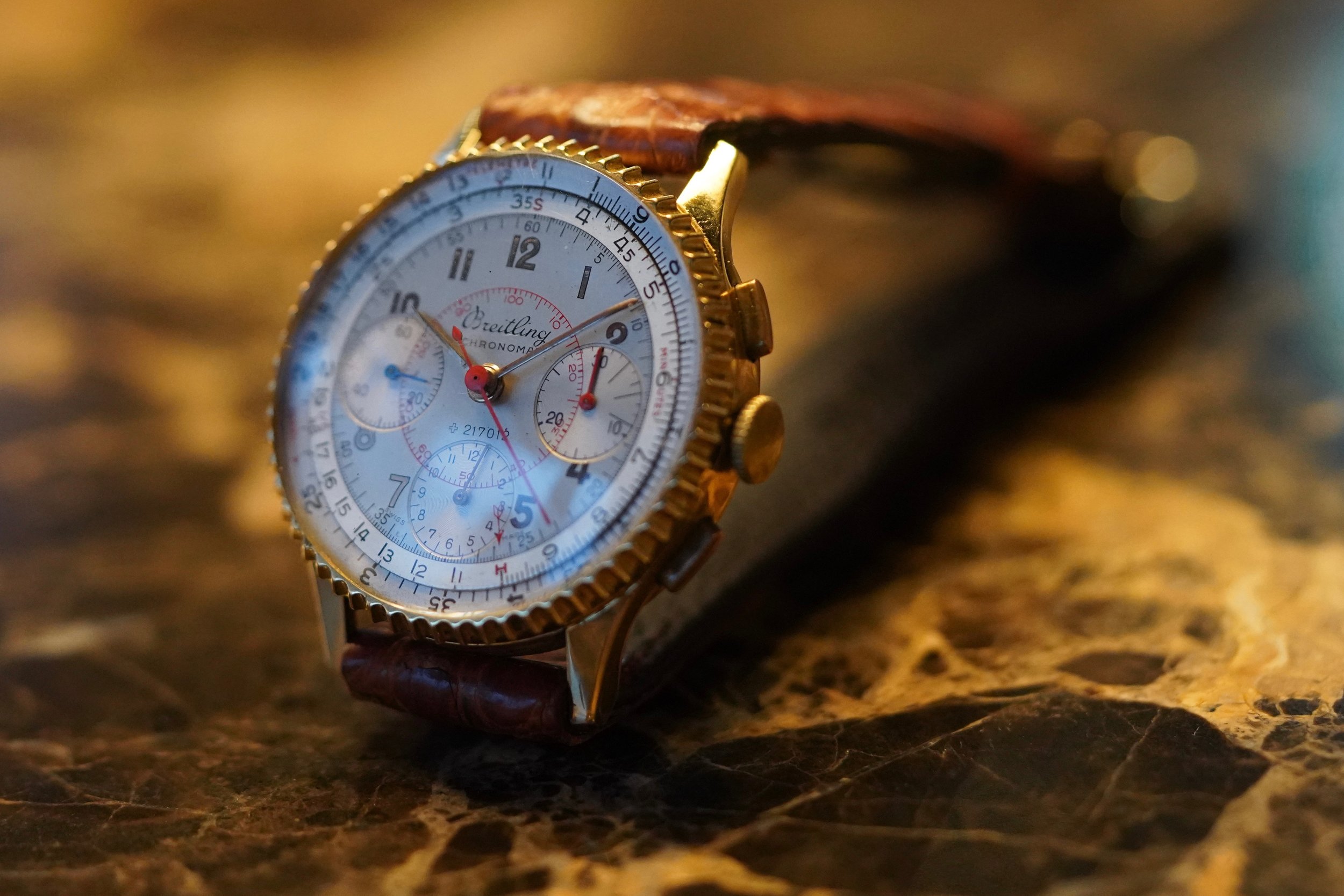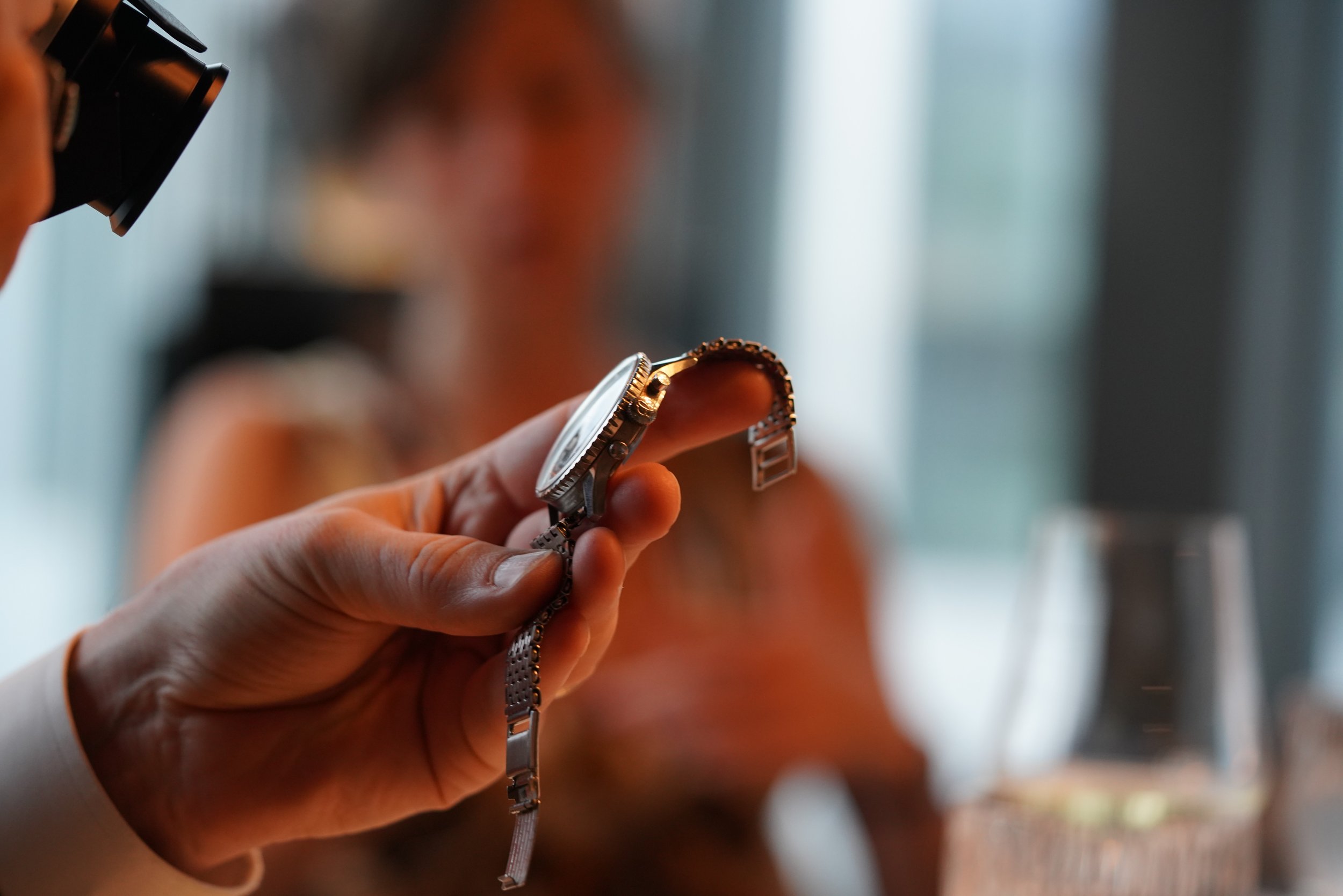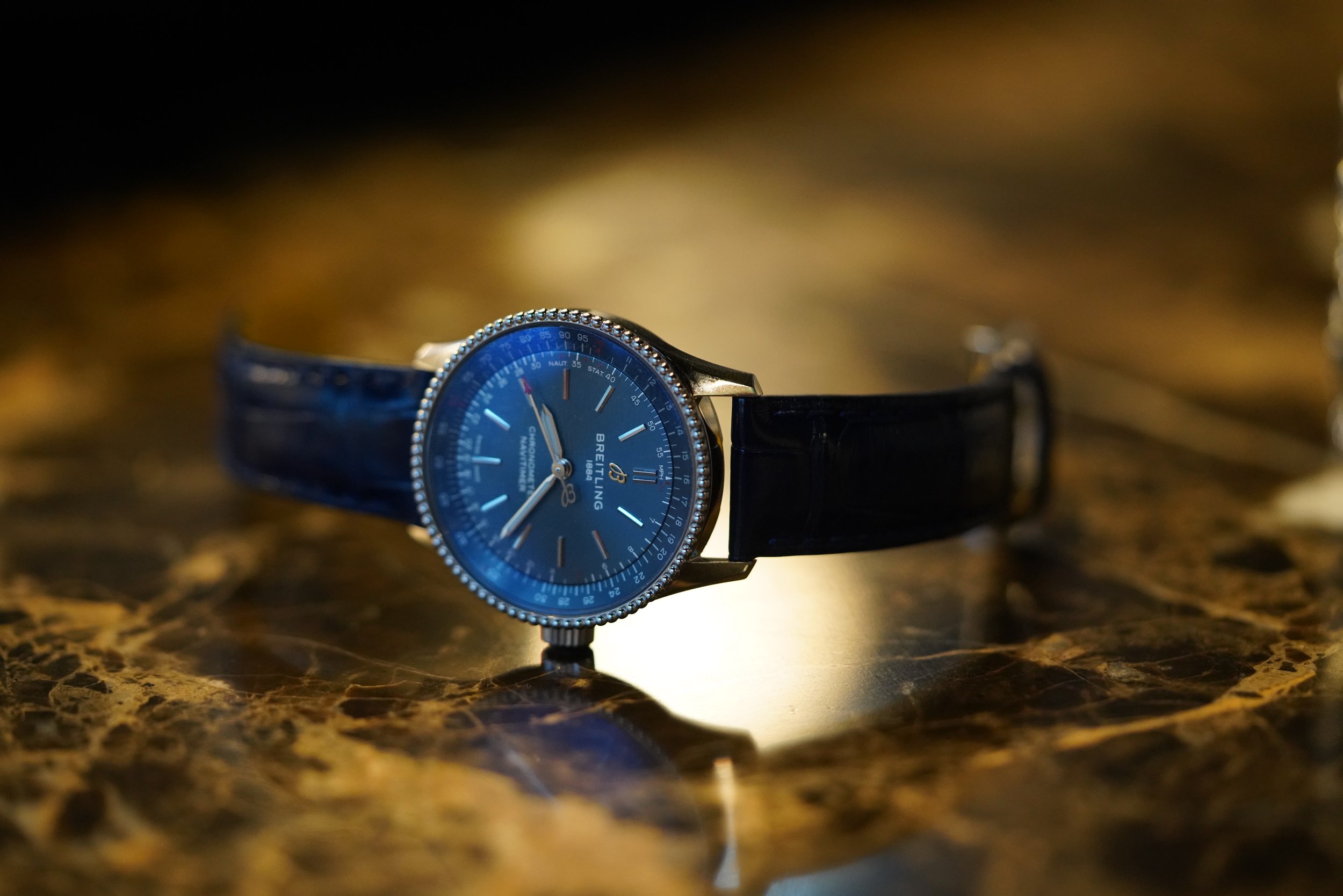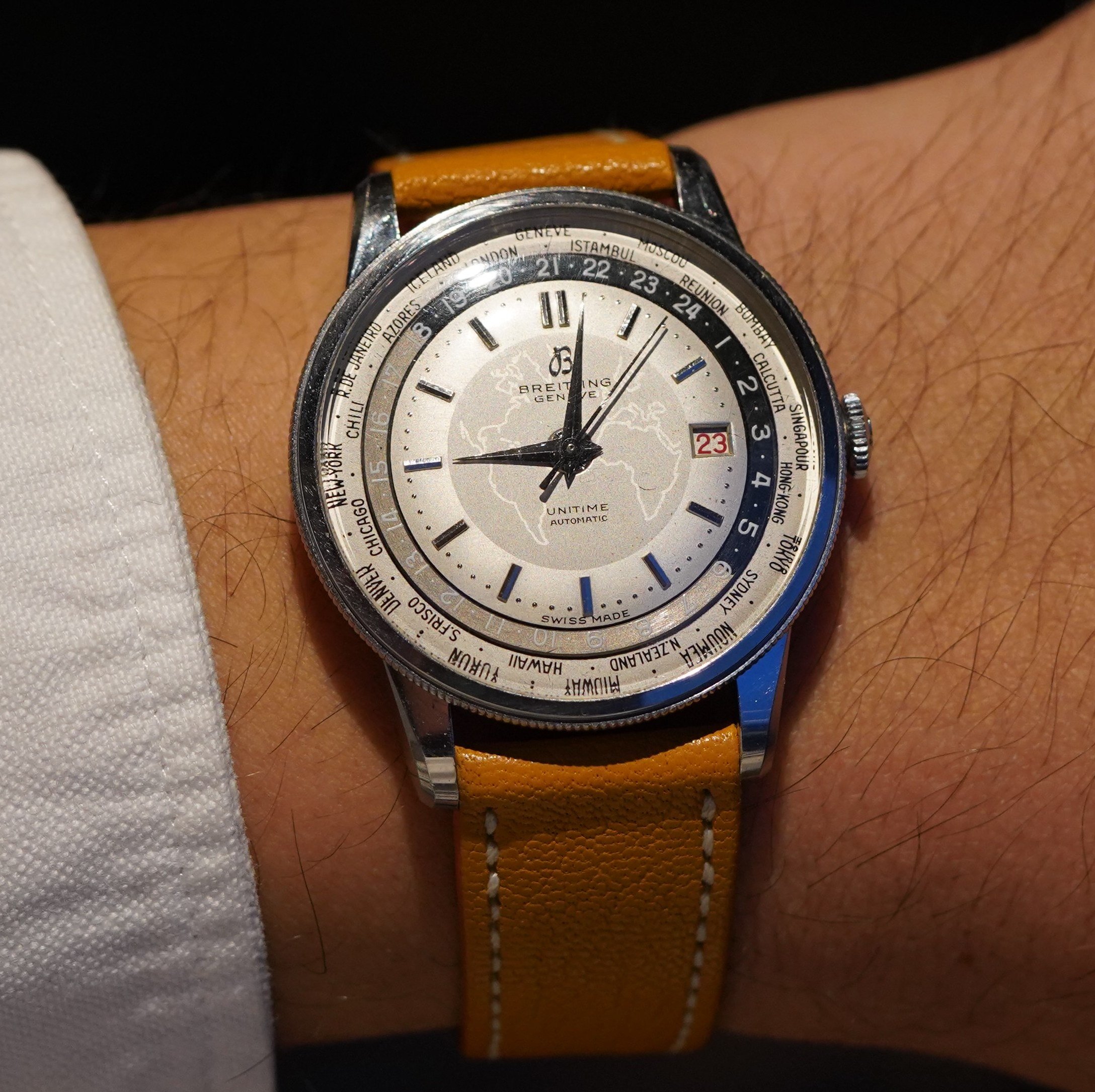Watch Spotting With Breitling: Part 3
By Charlie Dunne
Following up to both Watch Spotting At Breitling: Part 1 (photos from the Breitling event where Scott Carpenter’s Cosmonaute was unveiled to the world), and Watch Spotting At Breitling: Part 2 (a follow up dinner in which attendees spent the evening out in Zurich), we have the pleasure of sharing Part 3: a review of our first dinner organized by Lindsay Paterson of Breitling and Fred Mandelbaum. The dinner was a wonderful experience in which we were able to admire a wide breadth of vintage Breitling watches in an intimate setting. This is our last photo report from our Breitling trip in May and we hope you find the watches compelling.
On Eric Wind’s wrist was this early Navitimer reference 806 awarded to Matthew Rosenhaus by The Eddie Jacobson Memorial Foundation on April 29, 1956 in Kansas City, Missouri. Rosenhaus served as an honorary vice-chairman of the Anti-Defamation League of B’nai B’rith and vice president of the ADE Foundation. Notably, this Navitimer is powered by the Valjoux 72, which is an extremely rare and desirable variation. You can see it here.
Fred Mandelbaum brought a wide selection of vintage timepieces from his collection to the dinner. Above left is the reference 809 “COSMO Mk 6” in solid 18K gold. Upon looking at the case back, it was apparent the watch had important provenance. Mandellbaum would reveal the Cosmonaute was delivered to King Hussein bin Talal of Jordan circa 1966. Upon close inspection, the Swiss Poinçon de Maître hallmark 121 is well preserved indicating the case maker to be Guillod & Co.
Writer, photographer and resident “collector” at Quill & Pad, Gary Getz, was spotted wearing a wonderful vintage Mathey-Tissot Type XX which he acquired from Wind Vintage in 2021. Gary wrote about the timepiece in the article ‘ Why I Bought It: Vintage Mathey-Tissot Type 20 Big Eye Chronograph’.
Jeff Stein, the famous watch researcher and founder of OnTheDash, chatted with Eric about when he purchased his first vintage Breitling chronograph (a Scott Carpenter). Stein wore a black gilt, glossy dial reference 765 chronograph and shared how he had great luck acquiring it in Charleston, South Carolina while hunting vintage watches.
Patent 217012 “Pièce d'horlogerie permettant d'effectuer des opérations tachymétriques et télémétriques” applied for on 8/26/1940. Image credit: espacenet.com
This particular Chronomat belonged to the Austrian collector features the engraving “Presented to Tom Watts by Mario Lanza 9-5-52”. Mandelbaum revealed the watch was a gift to a composer/producer by the famous singer. Fred acquired the watch from Christie’s while Eric Wind worked there. After Eric saw the watch, he wrote Fred and essentially said “I think I may have something for sale that you will want” - this extremely rare reference 786 in pink gold with amazing provenance. Given the 18k pink gold case and the three-register movement, it would have been among the most expensive Breitling chronographs of the era.
Advertisement featuring the Breitling Chronomat. Image credit: https://www.adpatina.com
Advertisement featuring the Breitling Chronomat. Image credit: https://www.adpatina.com
Blake Buettner, Managing Editor of Worn & Wound, wearing his modern Rolex Explorer.
When asked whether he collected time-only Breitling watches, Mandelbaum would emphasize the manufacturer’s history centers around the chronograph wristwatch. While vintage models such as the Transocean have fascinated him, it is truly the complicated models that have maintained his attention over the years.
Barbara Palumbo, Editor-at-large of Revolution Watch, and Contributor to outlets such as Vanity Fair On Time, wore her blue-dial Chronometer Navitimer. One of the few writers in the watch industry with a keen ability to use satire, Palumbo was the life of the party.
At the table we met a fellow Floridian, now based in Frankfürt by the name of Michael Stockton. Stockton was among the many Fratello Watch team members in Zürich for the event and he brought with him a special Breitling for the occasion.
One of the most interesting models passed around the table was a Cosmonaute “Big Case” reference 819. The watch dates to circa 1968 and features compact lugs which give off an all-dial impression on the wrist. The orange accents ushered in during the late 1960s add a striking touch of flair when compared to the previous generations of Navitimers.
Insights into the large-size cases from this era can be found in the recent publication ‘Navitimer Story: The epic saga of the Breitling chronograph’. Breitling would enlist Ervin Piquerez (EPSA), inventor of the ingenious-compressor dive cases, to construct a model to accommodate the “gear-driven double rotating bezel” system which allowed the crystal to not rotate simultaneously like within earlier models. Accomplished through patent application 11525/67, the task was only something equipped for a water-resistant specialist EPSA.
Vintage Breitling advertisement featuring the Breitling Unitime reference 1-260. Image credit: https://www.adpatina.com/
Perhaps the most breathtaking wristwatch appeared in the form of Mandelbaum’s Duograph reference 791 - a “rattrapante” or “split second” chronograph. The non-luminous dial and “feuille" (or “leaf") hands immediately caught one’s attention. The dial was absolutely gorgeous with only a minimal amount of character in the subdials. Along with the twisted lugs and unpolished case, this Breitling was among the most outstanding split-seconds chronographs across all manufacturers. Handling these special timepieces and passionate collectors throughout the evening would not only enrich the brand’s history but also provide an optimistic outlook on the direction of the brand’s future.
Special thanks to Breitling, Fred Mandelbaum, Nicolas Chambron, Louis Westphalen, Lindsay Paterson, Romy Hebden, Sylvain Berneron, Santa Kalna, Letizia Garrapa, Georges Kern, and the rest of the Breitling team for hosting us at one of the best watch events we have ever attended. Additionally, a very special thanks to Nick Federowicz of Ad Patina.
Charlie Dunne is the Director of Content and Research for Wind Vintage and has been published and quoted in numerous other watch publications. You can also find more of his writing on StrictlyVintageWatches.com.














































